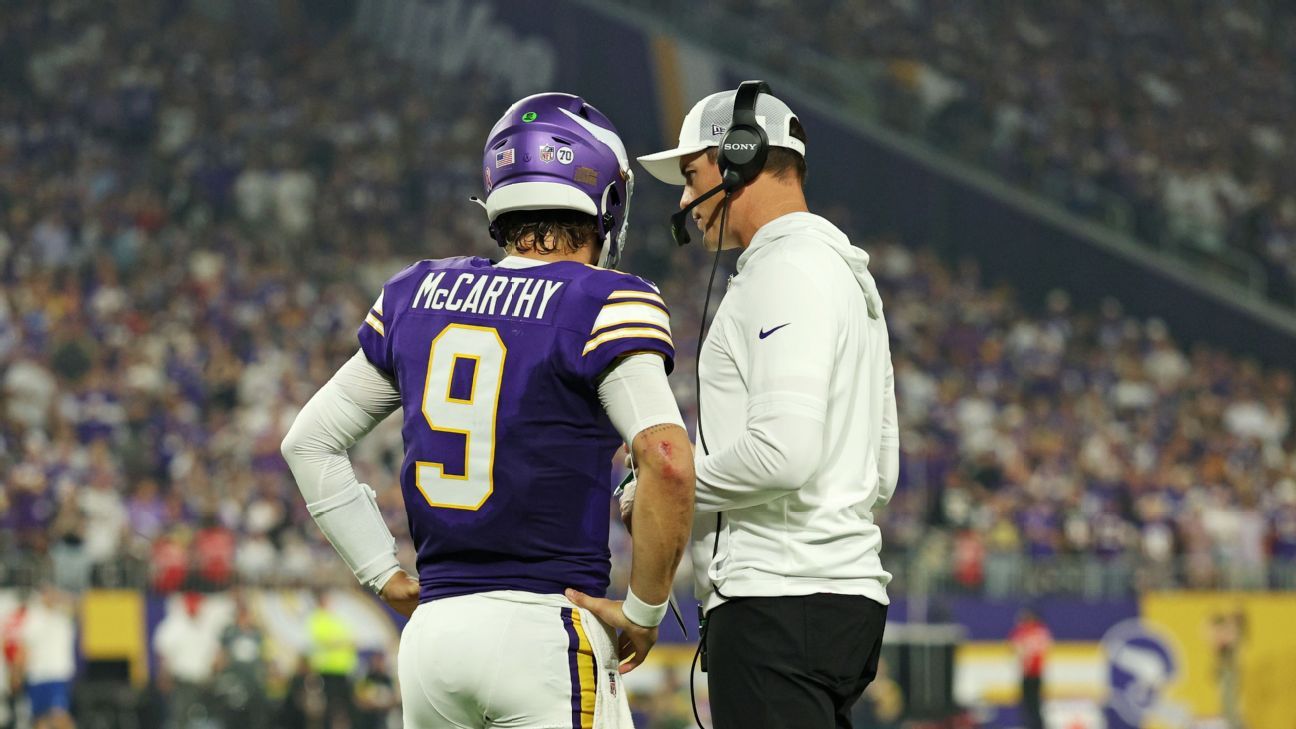
EAGAN, Minn. -- The playcall stayed with Minnesota Vikings coach Kevin O'Connell late into Sunday night.
The Vikings had faced third-and-1 from midfield, hoping to extend a 10-9 lead on the opening possession of the third quarter against the Baltimore Ravens. O'Connell did what he has done more often than any of his peers in similar situations since arriving in Minnesota four seasons ago. He called a pass, and not just a safe rollout or quick throw to the flat. The play was a deep throw to All-Pro receiver Justin Jefferson, designed to induce single coverage from the Ravens' defense, with the idea that the Vikings could always run on fourth down if it fell incomplete.
The result was far more disastrous. Jefferson tripped and fell during contact with Ravens cornerback Marlon Humphrey, leaving Humphrey to grab an easy interception of quarterback J.J. McCarthy's throw. The play sparked a turning point in a game the Vikings lost 27-19.
O'Connell said Monday that he wrestled with the call. With a young quarterback, should he have dialed back his trademark aggressiveness? Would a better option have been running backs Aaron Jones Sr. or Jordan Mason, who have converted six first downs in nine attempts this season via rushes when it was third- or fourth-and-short? Did O'Connell underestimate what he called the 1% chance that Jefferson would fall?
Ultimately, O'Connell said, the answer was clear.
"Best receiver in football in a one-on-one with a run call you feel good about on fourth-and-1," O'Connell said. "I would not change that call."
The episode -- the call, the internal second-guessing and the stalwart affirmation -- neatly encapsulated the way O'Connell is threading the needle of McCarthy's debut season. The Vikings have built a roster they hoped would support a quarterback developing in real time, and O'Connell has made some incremental changes to his scheme and playcalling. But it is clear that he has not changed his core beliefs. What has emerged, following McCarthy's return from a high right ankle sprain, is that O'Connell's method for quarterback development includes putting the player in some difficult and uncomfortable positions to help spur growth.
As a result, the Vikings are not simply giving McCarthy one-read plays and easy throws. They are still pushing the ball down the field. Among the 46 NFL quarterbacks who have made at least one start this season, McCarthy has the highest average air yards per throw at 10.1.
O'Connell is still calling passes on third-and-short as much as any offensive playcaller in the league, even as it contributes to one of the NFL's lowest third-down conversion rates. The Vikings' pre-snap motions have continued at roughly the same rate (60%) as they did from 2022 to 2024, which might have contributed to a team-record eight false starts in Sunday's game. O'Connell has even maintained his affinity for double-pass trick plays, including one to McCarthy from Jefferson that fell two yards short of a first down against the Ravens.
"Part of the growth and development is we've got to let him play a little bit," O'Connell said of McCarthy, "and we're trying to figure out that balance that gives you a chance ... to win the football game in the end. Every snap right now, there's major growth in learning and teaching going on for a guy that was really making his fourth start."
O'Connell famously said in 2024 that "organizations fail young quarterbacks before young quarterbacks fail organizations." He is hyper-aware of the ways McCarthy could be overwhelmed by the circumstances around him. That's largely why the Vikings sidelined him for the full six weeks of his original two-to-six-week recovery timetable from the ankle injury, even though he was available as their emergency third quarterback for the final two weeks. O'Connell did not want McCarthy trying to compensate for an injury while also managing the workload he planned to give him.
Since returning, McCarthy has used his mobility to run 14 times for 60 yards and a touchdown, while also moving 17 of his 78 dropbacks out of the pocket, tied for the third most in the NFL over that period. After his first game back, a 27-24 upset of the Detroit Lions, McCarthy thanked O'Connell "for his perspective on dealing with" the injury "because I felt like I went out there a hundred percent and just back where I left off."
And while there are some high-end levels of the Vikings' offense that have remained dormant, O'Connell has still given McCarthy a full NFL-level workload. In the Vikings' past two games, O'Connell has called a designed pass on 67.8% of their plays. That includes 83.8% in the second half against the Ravens as they fell behind by two scores and dealt with a total of eight false start penalties that limited running opportunities. McCarthy's accuracy dipped noticeably as the game wore on, and in the fourth quarter, 40% of his throws were off target, according to ESPN Research.
"I just think it's all normal, in my opinion," O'Connell said, "part of kind of where he's at and his development, which is something that's very encouraging. The great part is seeing the [competitiveness] and the will to win and his ability to play that style of game that we had to play, especially late. But that's not the game we want to play right now, and I got to do a better job keeping us in that game."
That attempt at balancing McCarthy's development with giving the nearly $350 million roster a chance to win explains why the third-and-1 playcall stayed with O'Connell for hours after Sunday's game. But his decision, and doubling down the next day, should not be a surprise for long-term observers of his playcalling in Minnesota.
From 2022 to 2024, the Vikings had the NFL's highest percentage of passes on third-and-1 or third-and-2 in the NFL (61.2%). Their conversion rate on such plays was 63.1%, No. 16 in the NFL. This season, which includes five starts by backup Carson Wentz and four by McCarthy, the Vikings are tied with the Lions for the highest rate of passes in those situations (58.3%) and are No. 32 in conversions (33.3%).
McCarthy has had nine dropbacks in those situations. He has attempted five passes (all incomplete), taken three sacks and rushed one time for 14 yards and a first down.
In total, the Vikings' approach with McCarthy has provided enough impressive NFL-caliber throws to give them confidence that he is on the right track. The most notable example was a 16-yard back-shoulder throw he lofted to receiver Jalen Nailor on third-and-5 to seal a 27-24 upset of the Lions in Week 9.
Those plays, however, exist amid a much larger landscape of foibles. In total, McCarthy ranks among the lowest-performing quarterbacks in the NFL this season. Of the 46 quarterbacks who have made at least one start, McCarthy's QBR (26.8) and off-target percentage (22.1%) both rank No. 44. His average yards per game (173) ranks No. 32.
McCarthy, for one, has taken an appropriately long-term approach. Each play -- good, bad or indifferent -- is another data point to download and use for future experiences.
"I feel like the greatest learning tool for anybody, regardless of position, regardless of profession, is experience," he said.

